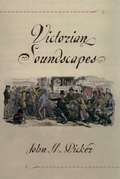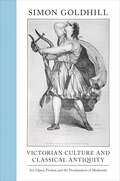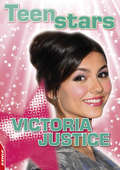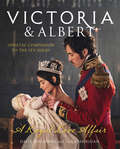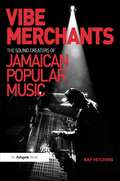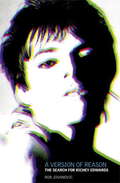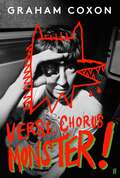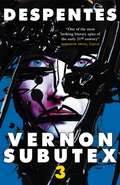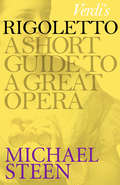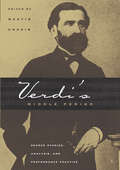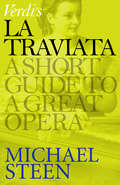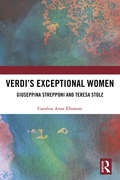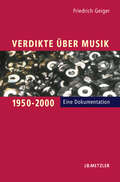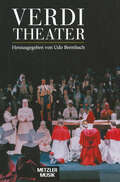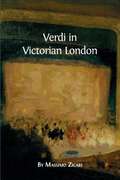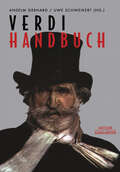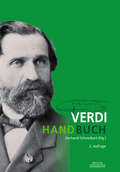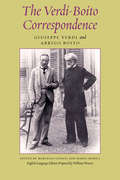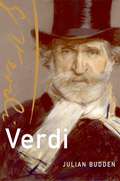- Table View
- List View
Victorian Soundscapes
by John M. PickerFar from the hushed restraint we associate with the Victorians, their world pulsated with sound. This book shows how, in more ways than one, Victorians were hearing things. The representations close listeners left of their soundscapes offered new meanings for silence, music, noise, voice, and echo that constitute an important part of the Victorian legacy to us today. In chronicling the shift from Romantic to modern configurations of sound and voice, Picker draws upon literary and scientific works to recapture the sense of aural discovery figures such as Babbage, Helmholtz, Freud, Bell, and Edison shared with the likes of Dickens, George Eliot, Tennyson, Stoker, and Conrad.
Victorian Culture and Classical Antiquity: Art, Opera, Fiction, and the Proclamation of Modernity
by Simon GoldhillHow did the Victorians engage with the ancient world? Victorian Culture and Classical Antiquity is a brilliant exploration of how the ancient worlds of Greece and Rome influenced Victorian culture. Through Victorian art, opera, and novels, Simon Goldhill examines how sexuality and desire, the politics of culture, and the role of religion in society were considered and debated through the Victorian obsession with antiquity. Looking at Victorian art, Goldhill demonstrates how desire and sexuality, particularly anxieties about male desire, were represented and communicated through classical imagery. Probing into operas of the period, Goldhill addresses ideas of citizenship, nationalism, and cultural politics. And through fiction--specifically nineteenth-century novels about the Roman Empire--he discusses religion and the fierce battles over the church as Christianity began to lose dominance over the progressive stance of Victorian science and investigation. Rediscovering some great forgotten works and reframing some more familiar ones, the book offers extraordinary insights into how the Victorian sense of antiquity and our sense of the Victorians came into being. With a wide range of examples and stories, Victorian Culture and Classical Antiquity demonstrates how interest in the classical past shaped nineteenth-century self-expression, giving antiquity a unique place in Victorian culture.
Victorian Culture and Classical Antiquity: Art, Opera, Fiction, and the Proclamation of Modernity
by Simon GoldhillHow did the Victorians engage with the ancient world? Victorian Culture and Classical Antiquity is a brilliant exploration of how the ancient worlds of Greece and Rome influenced Victorian culture. Through Victorian art, opera, and novels, Simon Goldhill examines how sexuality and desire, the politics of culture, and the role of religion in society were considered and debated through the Victorian obsession with antiquity. Looking at Victorian art, Goldhill demonstrates how desire and sexuality, particularly anxieties about male desire, were represented and communicated through classical imagery. Probing into operas of the period, Goldhill addresses ideas of citizenship, nationalism, and cultural politics. And through fiction--specifically nineteenth-century novels about the Roman Empire--he discusses religion and the fierce battles over the church as Christianity began to lose dominance over the progressive stance of Victorian science and investigation. Rediscovering some great forgotten works and reframing some more familiar ones, the book offers extraordinary insights into how the Victorian sense of antiquity and our sense of the Victorians came into being. With a wide range of examples and stories, Victorian Culture and Classical Antiquity demonstrates how interest in the classical past shaped nineteenth-century self-expression, giving antiquity a unique place in Victorian culture.
Victoria Justice (EDGE: Teen Stars #1)
by Jenny VaughanWelcome to Teen Stars! Whether you're already a fan, or just want to find out more, this series has something for everyone who's into the teen celebrity scene.
Victoria and Albert – A Royal Love Affair: A Royal Love Affair
by Daisy Goodwin Sara SheridanThe second tie-in to ITV drama Victoria unveils the complex, passionate relationship of Victoria and Albert.
Vibe Merchants: The Sound Creators Of Jamaican Popular Music (Ashgate Popular and Folk Music Series)
by Ray HitchinsVibe Merchants offers an insider’s perspective on the development of Jamaican Popular Music, researched and analysed by a thirty-year veteran with a wide range of experience in performance, production and academic study. This rare perspective, derived from interviews and ethnographic methodologies, focuses on the actual details of music-making practice, rationalized in the context of the economic and creative forces that locally drive music production. By focusing on the work of audio engineers and musicians, recording studios and recording models, Ray Hitchins highlights a music creation methodology that has been acknowledged as being different to that of Europe and North America. The book leads to a broadening of our understanding of how Jamaican Popular Music emerged, developed and functions, thus providing an engaging example of the important relationship between music, technology and culture that will appeal to a wide range of scholars.
Vibe Merchants: The Sound Creators Of Jamaican Popular Music (Ashgate Popular and Folk Music Series)
by Ray HitchinsVibe Merchants offers an insider’s perspective on the development of Jamaican Popular Music, researched and analysed by a thirty-year veteran with a wide range of experience in performance, production and academic study. This rare perspective, derived from interviews and ethnographic methodologies, focuses on the actual details of music-making practice, rationalized in the context of the economic and creative forces that locally drive music production. By focusing on the work of audio engineers and musicians, recording studios and recording models, Ray Hitchins highlights a music creation methodology that has been acknowledged as being different to that of Europe and North America. The book leads to a broadening of our understanding of how Jamaican Popular Music emerged, developed and functions, thus providing an engaging example of the important relationship between music, technology and culture that will appeal to a wide range of scholars.
A Version of Reason: The Search for Richey Edwards
by Rob JovanovicThe missing Manic - an authoritative look into the life and times of Richey Edwards, the Manic Street Preachers' guitarist who disappeared in 1995.The disappearance of Richey Edwards, troubled guitarist with the Manic Street Preachers, is one of rock and roll's great unresolved mysteries. His Vauxhall Cavalier was found abandoned in a service station car park near the Severn Bridge, a notorious suicide spot, in February 1995, a fortnight after Edwards had last been seen. The location of the car and the tape left in the deck - Nirvana's album In Utero - tended to point to one conclusion. However, it almost seemed too obvious a statement, and in A VERSION OF REASON, Rob Jovanovic unravels the complicated life and final days of Richey Edwards. Piecing together testimony from those close to Edwards Jovanovic seeks to produce an authoritative account of the life and times of Richey Edwards.
Verse, Chorus, Monster!
by Graham CoxonAmong the noise and clamour of the Britpop era, Blur co-founder Graham Coxon managed to carve out a niche to become one of the most innovative and respected guitarists of his generation - but it wasn't always easy.Graham grew up as an Army kid, moving frequently in his early years from West Germany to Derbyshire and Winchester before settling in Colchester, Essex. A shy child, he had a thing for eating soil and drawing intense visions; his anxiety was tempered by painting and a growing love of music.These twin passions grew into obsessions, and as he honed his artistic skill at school, Goldsmiths and beyond, his band with school friend Damon Albarn, fellow student Alex James, and a drummer called Dave Rowntree began to get noticed.But there are things they don't tell you before you get famous. There are monsters out there. And some may even be lurking inside yourself.Verse, Chorus, Monster! is an intimate, honest reflection on music, fame, addiction and art by one of Britain's most iconic musicians.
Vernon Subutex Three
by Virginie DespentesAlthough it means leaving behind the community of disciples who have followed him on his travels and assembled at his raves and gatherings, Vernon Subutex is compelled to return to Paris to visit the dentist.Once back in the city, he learns that Charles, his old friend from his days on the Paris streets, has died and left him half of a lottery win. But when Vernon returns to his disciples with news of this windfall, it does not take long before his followers start to turn on each other, and his good fortune provokes ruptures in his once harmonious community.Meanwhile, storm clouds are gathering for Aïcha and Céleste: Laurent Dopalet is determined to make them pay for their attack on him, whatever it takes and whoever gets hurt. And before long, the whole of Paris will be reeling in the wake of the terrorist atrocities of 2015 and 2016, and all the characters in this kaleidoscopic portrait of a city will be forced to a reckoning with each other.
Verdi's Rigoletto: A Short Guide to a Great Opera (Great Operas)
by Michael SteenFrom the première of Rigoletto at Venice’s La Fenice in 1851, the Duke’s La donna è mobile caught on with the public and has done much to ensure the ongoing popularity of Verdi’s opera about the body in the sack. Rigoletto, the sarcastic court jester, is cursed by a nobleman who he has mocked. Subsequent events see the curse realised, as Rigoletto’s daughter Gilda is kidnapped, raped, and later killed. The story, originally about King François, contemporary of the English King Henry VIII, came from a novel by Victor Hugo, author of Les Misérables and the Hunchback of Notre Dame. Concerned by its combination of debauchery, seduction, rape by a king, regicide, kidnap and murder, the censors required the librettist Francesco Piave to relocate it from the Louvre in Paris to the court in Mantua. The wonderful music also includes the Duke’s Questa o quella, Gilda’s Caro nome, Rigoletto’s Piangi! piangi fanciulla and the glorious ensemble Bella figlia dell’amore. Enrico Caruso made his début at the Metropolitan Opera House as Rigoletto. Others who have starred include Patti, Melba, Callas, Domingo and Pavarotti. Written by Michael Steen, author of the acclaimed The Lives and Times of the Great Composers, ‘Short Guides to Great Operas’ are concise, entertaining and easy to read. They are packed with useful information and informed opinion, helping to make you a truly knowledgeable opera-goer, and so maximising your enjoyment of a great musical experience. Other ‘Short Guides to Great Operas’ that you may enjoy include La Traviata, Tosca and Lucia di Lammermoor.
Verdi's Middle Period: Source Studies, Analysis, and Performance Practice
by Martin Chusid Kathleen K. Hansell Philip GossettDuring the middle phase of his career, 1849-59, Verdi adopted new compositional procedures to create some of his best-loved and most-performed works. Focusing on the operas he composed during this period, this volume explores Verdi's work from three interlinked perspectives: studies of the original source material, cross-disciplinary analyses of musical and textual issues, and the relationship of performance practice to Verdi's musical and dramatic conception. In addition to offering new insights into such staples as Il trovatore, La traviata, and Un ballo in maschera, Verdi's Middle Period also highlights works which have only recently begun to re-enter public consciousness, such as Stiffelio, as well as lesser-known works such as Luisa Miller and Les Vêpres siciliennes. Comprising major essays by some of the best-known Verdians of our day, as well as articles from up-and-coming scholars, this volume has much to offer readers ranging from musicologists to serious opera buffs. Contributors are Martin Chusid, Markus Engelhardt, Linda B. Fairtile, Philip Gossett, Kathleen Kuzmick Hansell, Elizabeth Hudson, James Hepokoski, Roberta Montemorra Marvin, Carlo Matteo Mossa, Roger Parker, Harold S. Powers, David Rosen, and Mary Ann Smart.
Verdi's La Traviata: A Short Guide to a Great Opera (Great Operas)
by Michael SteenVerdi’s now-popular opera was a fiasco in Venice in 1853, attributable perhaps to the prima donna being noticeably obese, despite apparently wasting with tuberculosis. Soon, however, Verdi’s scandalous love story was on stage contemporaneously at Her Majesty’s Theatre, Covent Garden and Drury Lane. Piave’s libretto depicts Violetta and Alfredo Germont, the Marguerite and Armand of The Lady with the Camelias by Alexandre Dumas (son of the author of The Count of Monte Cristo and The Three Musketeers). The bestseller was based on the short life of the courtesan Marie Duplessis, mistress of a duke, a viscount and a baron – in Paris the ‘oldest profession’, prostitution, was the only way many women could survive, as Victor Hugo’s Les Misérables depicts. Featuring some of Verdi’s best-loved tunes, such as the ‘Brindisi’ and Violetta’s Sempre libera, La Traviata is enduringly popular. Violetta has been sung by international operatic sopranos such as Patti and Melba, and recently Gheorghiu. Some, like Joan Sutherland, have preferred to stay off-stage and make an opera recording. Domingo and Pavarotti have sung the role of Alfredo. Written by Michael Steen, author of the acclaimed The Lives and Times of the Great Composers, ‘Short Guides to Great Operas’ are concise, entertaining and easy to read. They are packed with useful information and informed opinion, helping to make you a truly knowledgeable opera-goer, and so maximising your enjoyment of a great musical experience. Other ‘Short Guides to Great Operas’ that you may enjoy include Rigoletto, Carmen and La Bohème.
Verdi’s Exceptional Women: Giuseppina Strepponi and Teresa Stolz
by Caroline Anne EllsmoreThis investigation offers new perspectives on Giuseppe Verdi’s attitudes to women and the functions which they fulfilled for him. The book explores Verdi’s professional and personal relationship with women who were exceptional within the traditional socio-sexual structure of patria potestà, in the context of women’s changing status in nineteenth-century Italian society. It focusses on two women; the singers Giuseppina Strepponi, who supported and enhanced Verdi’s creativity at the beginning of his professional life and Teresa Stolz, who sustained his sense of self-worth at its end. Each was an essential emotional benefactor without whom Verdi’s career would not have been the same. The subject of the Strepponi-Verdi marriage and the impact of Strepponi’s past deserve further detailed and nuanced discussion. This book demonstrates Verdi’s shifting power-balance with Strepponi as she sought to retain intellectual self-respect while his success and control increased. The negative stereotypes concerning operatic ‘divas’ do not withstand scrutiny when applied either to Strepponi or to Stolz. This book presents a revisionist appraisal of Stolz through close examination of her letters. Revealing Stolz’s value to Verdi, they also provide contemporary operatic criticism and behind-the-scenes comment, some excerpts of which are published here in English for the first time.
Verdi’s Exceptional Women: Giuseppina Strepponi And Teresa Stolz
by Caroline Anne EllsmoreThis investigation offers new perspectives on Giuseppe Verdi’s attitudes to women and the functions which they fulfilled for him. The book explores Verdi’s professional and personal relationship with women who were exceptional within the traditional socio-sexual structure of patria potestà, in the context of women’s changing status in nineteenth-century Italian society. It focusses on two women; the singers Giuseppina Strepponi, who supported and enhanced Verdi’s creativity at the beginning of his professional life and Teresa Stolz, who sustained his sense of self-worth at its end. Each was an essential emotional benefactor without whom Verdi’s career would not have been the same. The subject of the Strepponi-Verdi marriage and the impact of Strepponi’s past deserve further detailed and nuanced discussion. This book demonstrates Verdi’s shifting power-balance with Strepponi as she sought to retain intellectual self-respect while his success and control increased. The negative stereotypes concerning operatic ‘divas’ do not withstand scrutiny when applied either to Strepponi or to Stolz. This book presents a revisionist appraisal of Stolz through close examination of her letters. Revealing Stolz’s value to Verdi, they also provide contemporary operatic criticism and behind-the-scenes comment, some excerpts of which are published here in English for the first time.
Verdikte über Musik 1950–2000: Eine Dokumentation
by Friedrich GeigerAmüsant bis skandalös: eine einzigartige Sammlung vernichtender Kritiken und Urteile zur Musik der Gegenwart. Der Band präsentiert einige hundert Texte - geordnet nach Komponisten -, ausgewählt aus Zeitungen, Zeitschriften und Fachbüchern. Beispiele des musikalischen Urteils aus den letzten fünfzig Jahren: von den Beatles und Boulez bis Weill, von Donizetti bis Sun Ra. Mit einem Register der Schmähungsarten.
Verdi-Theater
Verdi ist neben Mozart und Wagner der populärste Komponist des Musiktheaters. Die Autoren stellen exemplarisch sein Werk und dessen Bedeutung dar: Herkunft, Entwicklung, Dramaturgie, Form, Ästhetik und Rezeption.
Verdi in Victorian London (PDF)
by Massimo ZicariNow a byword for beauty, Verdi's operas were far from universally acclaimed when they reached London in the second half of the nineteenth century. Why did some critics react so harshly? Who were they and what biases and prejudices animated them? When did their antagonistic attitude change? And why did opera managers continue to produce Verdi's operas, in spite of their alleged worthlessness? Massimo Zicari's Verdi in Victorian London reconstructs the reception of Verdi's operas in London from 1844, when a first critical account was published in the pages of The Athenaeum, to 1901, when Verdi's death received extensive tribute in The Musical Times. In the 1840s, certain London journalists were positively hostile towards the most talked-about representative of Italian opera, only to change their tune in the years to come. The supercilious critic of The Athenaeum, Henry Fothergill Chorley, declared that Verdi's melodies were worn, hackneyed and meaningless, his harmonies and progressions crude, his orchestration noisy. The scribes of The Times, The Musical World, The Illustrated London News, and The Musical Times all contributed to the critical hubbub. Yet by the 1850s, Victorian critics, however grudging, could neither deny nor ignore the popularity of Verdi's operas. Over the final three decades of the nineteenth century, moreover, London's musical milieu underwent changes of great magnitude, shifting the manner in which Verdi was conceptualized and making room for the powerful influence of Wagner. Nostalgic commentators began to lament the sad state of the Land of Song, referring to the now departed "palmy days of Italian opera." Zicari charts this entire cultural constellation. Verdi in Victorian London is required reading for both academics and opera aficionados. Music specialists will value a historical reconstruction that stems from a large body of first-hand source material, while Verdi lovers and Italian opera addicts will enjoy vivid analysis free from technical jargon. For students, scholars and plain readers alike, this book is an illuminating addition to the study of music reception.
Verdi in Victorian London
by Massimo ZicariNow a byword for beauty, Verdi’s operas were far from universally acclaimed when they reached London in the second half of the nineteenth century. Why did some critics react so harshly? Who were they and what biases and prejudices animated them? When did their antagonistic attitude change? And why did opera managers continue to produce Verdi’s operas, in spite of their alleged worthlessness? Massimo Zicari’s Verdi in Victorian London reconstructs the reception of Verdi’s operas in London from 1844, when a first critical account was published in the pages of The Athenaeum, to 1901, when Verdi’s death received extensive tribute in The Musical Times. In the 1840s, certain London journalists were positively hostile towards the most talked-about representative of Italian opera, only to change their tune in the years to come. The supercilious critic of The Athenaeum, Henry Fothergill Chorley, declared that Verdi’s melodies were worn, hackneyed and meaningless, his harmonies and progressions crude, his orchestration noisy. The scribes of The Times, The Musical World, The Illustrated London News, and The Musical Times all contributed to the critical hubbub. Yet by the 1850s, Victorian critics, however grudging, could neither deny nor ignore the popularity of Verdi’s operas. Over the final three decades of the nineteenth century, moreover, London’s musical milieu underwent changes of great magnitude, shifting the manner in which Verdi was conceptualized and making room for the powerful influence of Wagner. Nostalgic commentators began to lament the sad state of the Land of Song, referring to the now departed "palmy days of Italian opera." Zicari charts this entire cultural constellation. Verdi in Victorian London is required reading for both academics and opera aficionados. Music specialists will value a historical reconstruction that stems from a large body of first-hand source material, while Verdi lovers and Italian opera addicts will enjoy vivid analysis free from technical jargon. For students, scholars and plain readers alike, this book is an illuminating addition to the study of music reception.
Verdi in Victorian London
by Massimo ZicariNow a byword for beauty, Verdi’s operas were far from universally acclaimed when they reached London in the second half of the nineteenth century. Why did some critics react so harshly? Who were they and what biases and prejudices animated them? When did their antagonistic attitude change? And why did opera managers continue to produce Verdi’s operas, in spite of their alleged worthlessness? Massimo Zicari’s Verdi in Victorian London reconstructs the reception of Verdi’s operas in London from 1844, when a first critical account was published in the pages of The Athenaeum, to 1901, when Verdi’s death received extensive tribute in The Musical Times. In the 1840s, certain London journalists were positively hostile towards the most talked-about representative of Italian opera, only to change their tune in the years to come. The supercilious critic of The Athenaeum, Henry Fothergill Chorley, declared that Verdi’s melodies were worn, hackneyed and meaningless, his harmonies and progressions crude, his orchestration noisy. The scribes of The Times, The Musical World, The Illustrated London News, and The Musical Times all contributed to the critical hubbub. Yet by the 1850s, Victorian critics, however grudging, could neither deny nor ignore the popularity of Verdi’s operas. Over the final three decades of the nineteenth century, moreover, London’s musical milieu underwent changes of great magnitude, shifting the manner in which Verdi was conceptualized and making room for the powerful influence of Wagner. Nostalgic commentators began to lament the sad state of the Land of Song, referring to the now departed "palmy days of Italian opera." Zicari charts this entire cultural constellation. Verdi in Victorian London is required reading for both academics and opera aficionados. Music specialists will value a historical reconstruction that stems from a large body of first-hand source material, while Verdi lovers and Italian opera addicts will enjoy vivid analysis free from technical jargon. For students, scholars and plain readers alike, this book is an illuminating addition to the study of music reception.
Verdi-Handbuch
by Christine FischerLeben, Zeit und Werk des Künstlers. Daran, dass die Oper im 19. Jahrhundert zur populärsten Kunstform in Italien wurde, hat Verdi einen großen Anteil. Das Handbuch liefert die wichtigsten sozial- und theatergeschichtlichen Fakten. Im Mittelpunkt des Handbuchs stehen vor allem Verdis Kompositionen. Die 26 Opern und alle weiteren Werke werden vor dem Hintergrund der Rezeptions- und Interpretationsgeschichte vorgestellt. Die detaillierte Zeittafel, das kommentierte Personenverzeichnis, das Glossar und die Auswahlbibliografie liefern wertvolle Zusatzmaterialien. Ein Handbuch für alle, die sich für Verdis Musik begeistern.
Verdi-Handbuch
Zum 200. Geburtstag von Giuseppe Verdi. Don Carlos, Otello, Falstaff das Handbuch stellt alle 26 Opern und die weiteren Werke Verdis einzeln vor. Es zeigt auch Verdis Weg bei der Entstehung seiner Opern: vom Libretto über Komposition, Stimmtypen, Vers-Vertonung bis zur Aufführung. Zeit- und Theatergeschichtliches vermitteln, warum die Oper nicht zuletzt durch Verdis Beitrag im 19. Jahrhundert so beliebt war. In der 2., stark überarbeiteten Auflage mit vielen neu verfassten Beiträgen und neuen Kapiteln u. a. zu Kompositionstechnik, Verdi-Renaissance nach 1918, Verdi-Dirigenten.
The Verdi-Boito Correspondence
by Arrigo Boito Giuseppe VerdiThese 301 letters between Giuseppe Verdi and his last, most gifted librettist, Arrigo Boito, document an extraordinary chapter in musical history. Now available for the first time in English, this correspondence records both a unique friendship and its creative legacy. This new edition of the landmark Carteggio Verdi/Boito is at once a valuable resource for all students, teachers, and scholars of opera and a fascinating glimpse of the daily life of European art and artists during the fertile last decades of the 19th century. Embarking on a 20-year collaboration, Verdi and Boito produced a successful revision of Simon Boccanegra, and two new operas, Otello and Falstaff. They created what many consider to be Verdi's greatest operas, thanks both to Boito's poetry and to his handling of the composer. Here are the day-to-day tasks of creation: poet and composer debating problems of dramatic structure, words, phrases, and meters; altering dialogue as, at the same time, they converse about the wider worlds of art and music. The give and take of artistic creation is rendered fascinatingly. This edition features a new introduction by Marcello Conati, improvements and updatings to the original edition, and an appendix of undated correspondence. William Weaver's translation is characteristically pitch-perfect; he also provides a short closing sketch of Boito's life after the death of his beloved maestro. Explanatory "linking texts" between the letters create a narrative.
Verdi (Master Musicians Series)
by Julian BuddenIn this third edition of the classic Verdi, renowned authority Julian Budden offers a comprehensive overview of Verdi the man and the artist, tracing his ascent from humble beginnings to the status of a cultural patriarch of the new Italy, whose cause he had done much to promote, and demonstrating the gradual enlargement over the years of his artistic vision. This concise study is an accessible, insightful, and engaging summation of Verdi scholarship, acquainting the non-specialist with the personal details Verdi's life, with the operatic world in which he worked, and with his political ideas, his intellectual vision, and his powerful means of communicating them through his music. In his survey of the music itself, Budden emphasizes the unique character of each work as well as the developing sophistication of Verdi's style. He covers all of the operas, the late religious works, the songs, and the string quartet. A glossary explains even the most obscure operatic terms current in Verdi's time.
Verdi (Master Musicians Series)
by Julian BuddenIn this third edition of the classic Verdi, renowned authority Julian Budden offers a comprehensive overview of Verdi the man and the artist, tracing his ascent from humble beginnings to the status of a cultural patriarch of the new Italy, whose cause he had done much to promote, and demonstrating the gradual enlargement over the years of his artistic vision. This concise study is an accessible, insightful, and engaging summation of Verdi scholarship, acquainting the non-specialist with the personal details Verdi's life, with the operatic world in which he worked, and with his political ideas, his intellectual vision, and his powerful means of communicating them through his music. In his survey of the music itself, Budden emphasizes the unique character of each work as well as the developing sophistication of Verdi's style. He covers all of the operas, the late religious works, the songs, and the string quartet. A glossary explains even the most obscure operatic terms current in Verdi's time.
